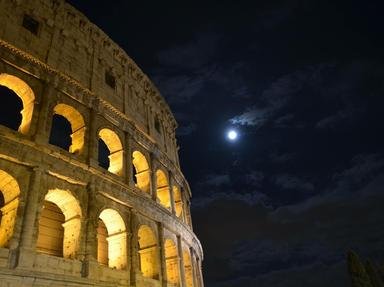Quiz Answer Key and Fun Facts
1. We know all about the famous first king of Rome, Romulus, but not so much about the second king, Numa. From which Sabine town did he hail?
2. More on Numa. He is credited with a great deal of reform in what area?
3. More from the legendary royal period. The Tarquin family is famous for many things, however they were not always called the Tarquins. What was the name of the first Tarquin king (Tarquinius Priscus) before he changed it to Tarquin?
4. Lucius Junius Brutus was famed as the liberator of Rome from Tarquin the Proud, and as one of the two original consuls of the new Republic. Who was the other consul?
5. There was a king who initially supported the Tarquin claim on Rome (for Tarquin the Proud was exiled, not killed), but later made peace with Rome. Who was this King?
6. Livy mentions specifically one historian as a reference for the royal parts of Rome's history. Who is this?
7. Rome fought many wars to establish control of the Italian peninsula. In particular, she fought fiercely with an Etruscan town only nine miles distant. What was this town?
8. Name the Italian people who fought three wars with Rome and were not truly crushed until 290BC.
9. Who was the general held responsible for the famous defeat at the Caudine Forks in the second Samnite War in 321BC?
10. The rostra was the platform from which orators usually spoke in the Forum. It was so named after objects attached to the platform as spoils of war, the first of which was won in 338BC in a victory over Antium. What were these objects?
11. There were many conflicts between the plebeians and the patricians in the Republic's turbulent early history. A Lex Hortensia passed in 287BC did what for the plebeians?
12. In 280BC, Pyrrhus, the King of Epirus, used elephants for the first time against Rome at what battle?
13. Heiro II can be said to have begun the First Punic War by attacking the who?
14. 237BC marked an important year on the Roman calendar. Two world changing events happened. One was the birth of Scipio Africanus, and the other was?
15. Marcus Claudius Marcellus, one of Rome's renowned generals during the Second Punic War, won fame before the war against Hannibal as one of only three generals to dedicate the spolia opima, or spoils of honor. Who was the Gallic chieftain Marcellus defeated to gain this honor?
16. The siege of Saguntum in Spain by Carthage triggered the Second Punic War. After what river was the treaty named, that Carthage supposedly violated?
17. Which famous mathematician helped Syracuse against Rome in the Second Punic War?
18. At the Isthmian Games in 196BC, Flamininus declared what?
19. What was built in the Forum in 179BC?
20. And finally, after the defeat of Perseus at Pydna, who was brought back a prisoner from Megalopolis to Rome.
Source: Author
messalla
This quiz was reviewed by FunTrivia editor
coolupway before going online.
Any errors found in FunTrivia content are routinely corrected through our feedback system.

